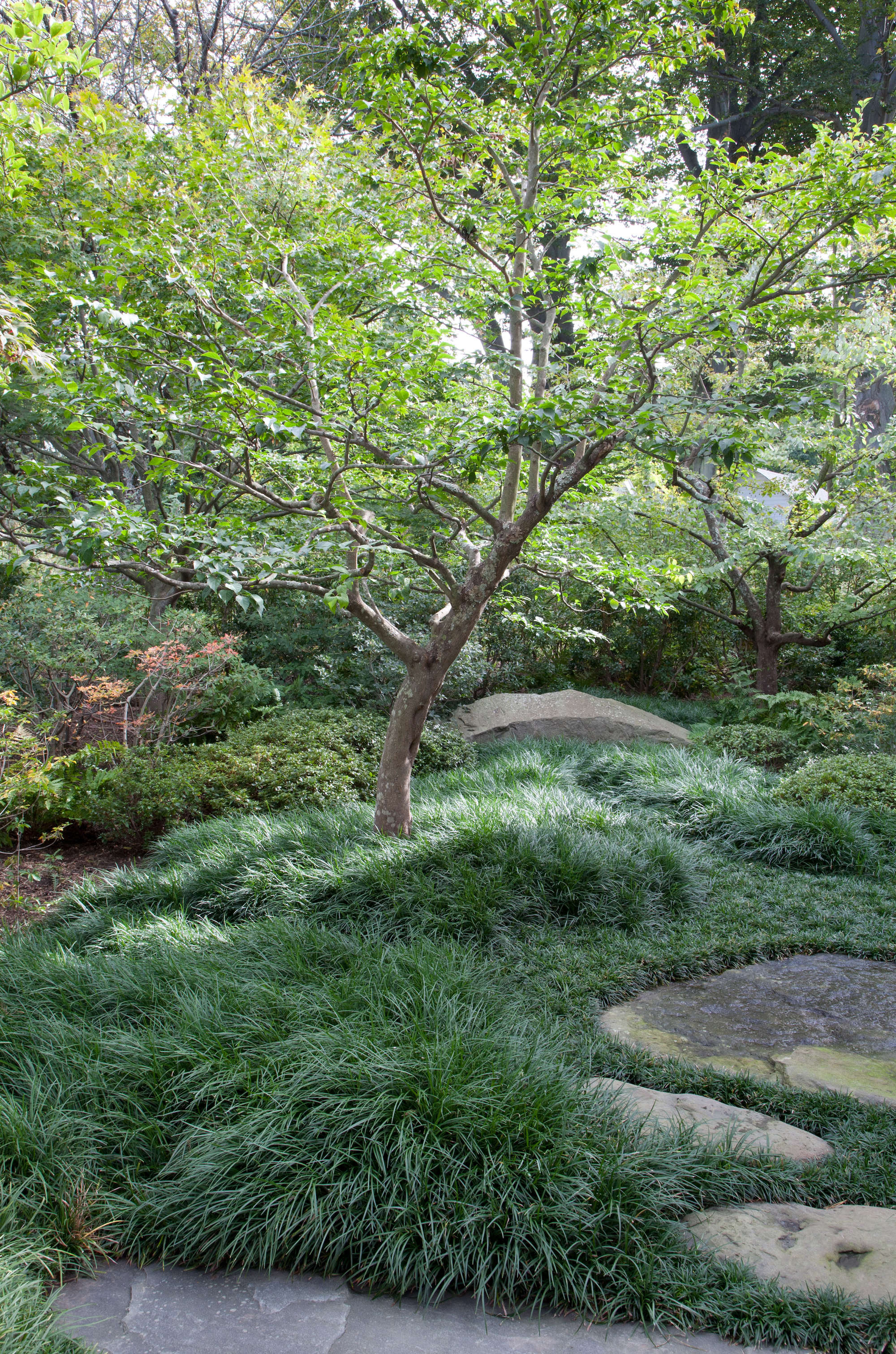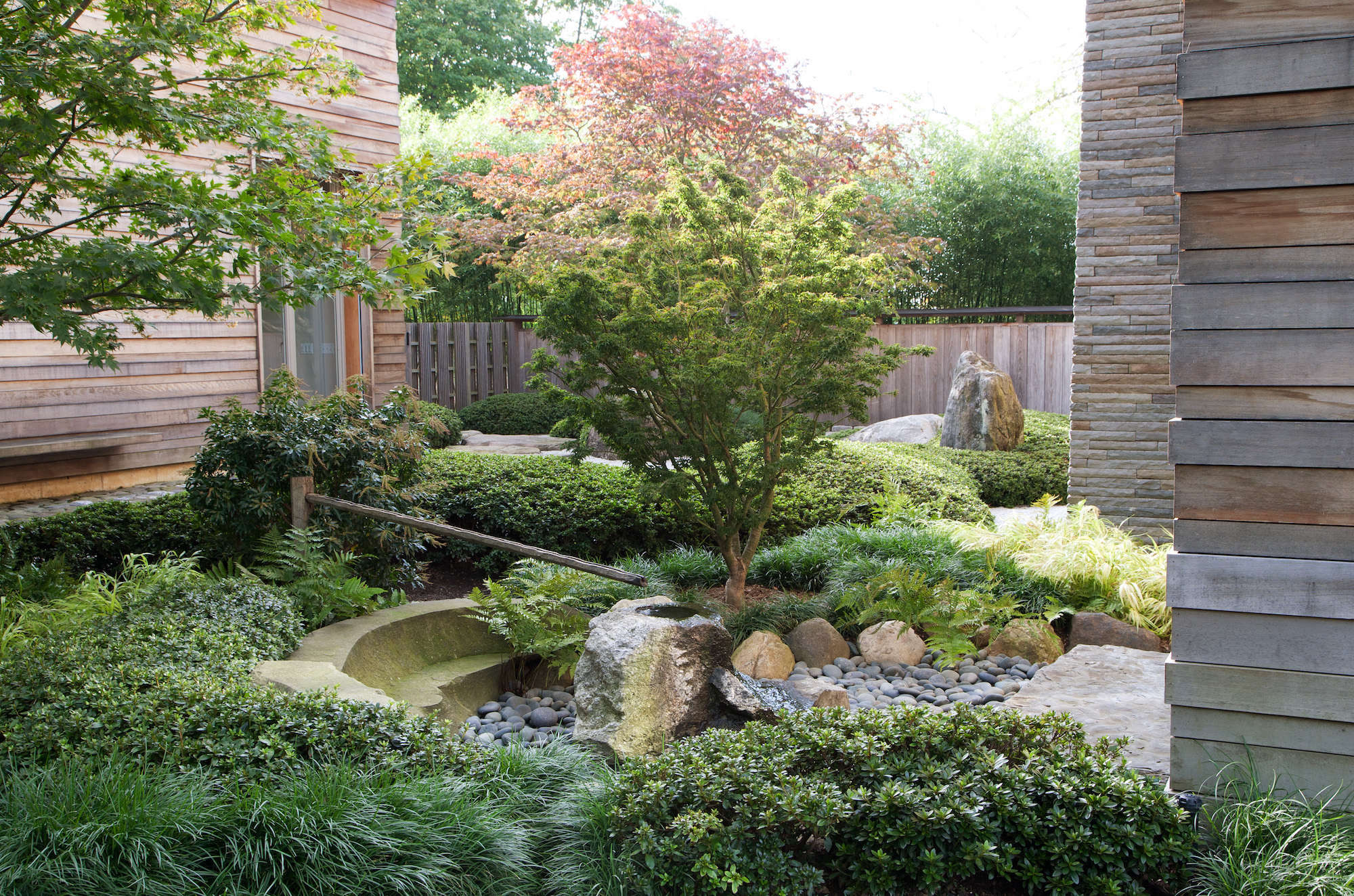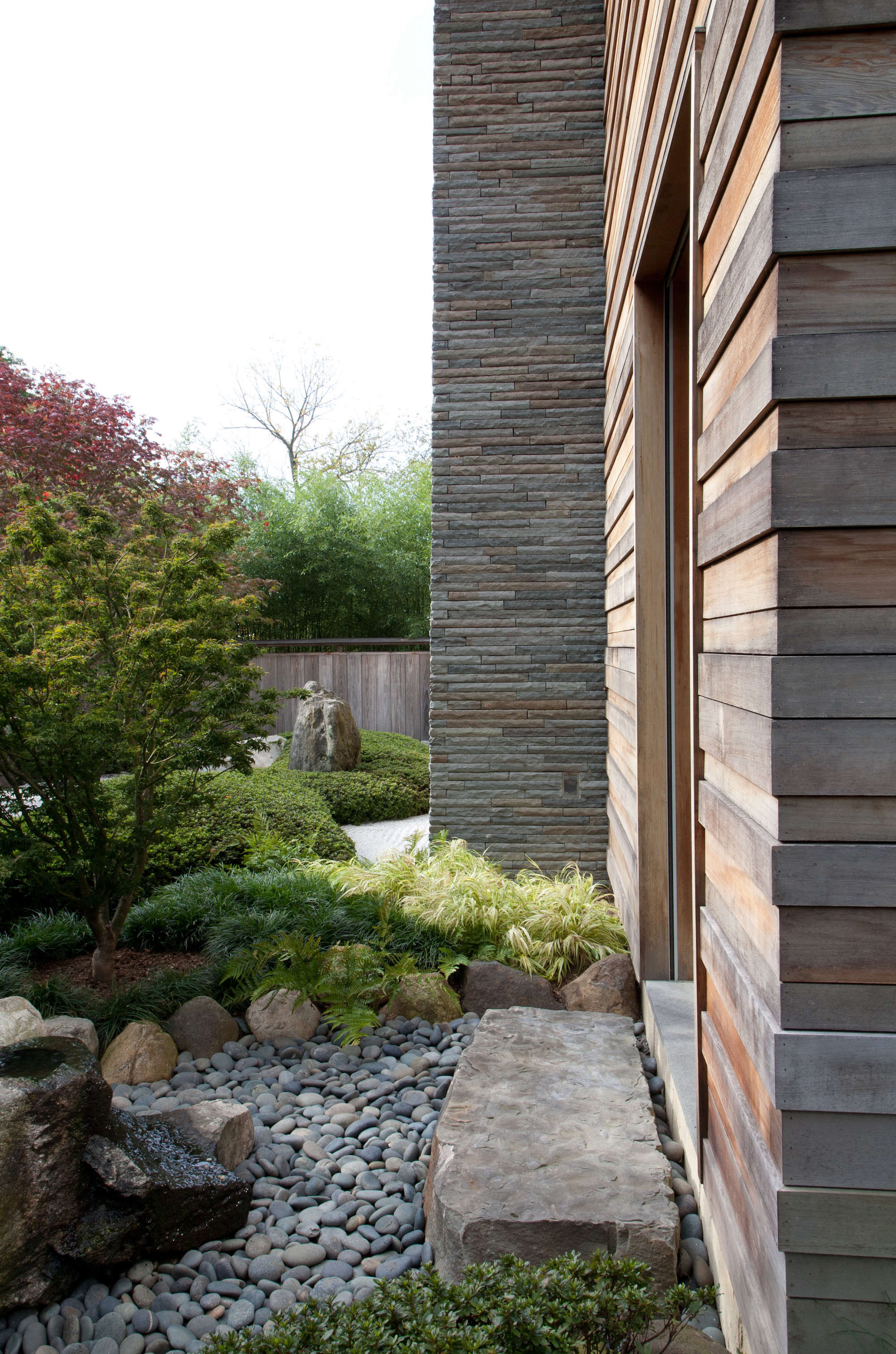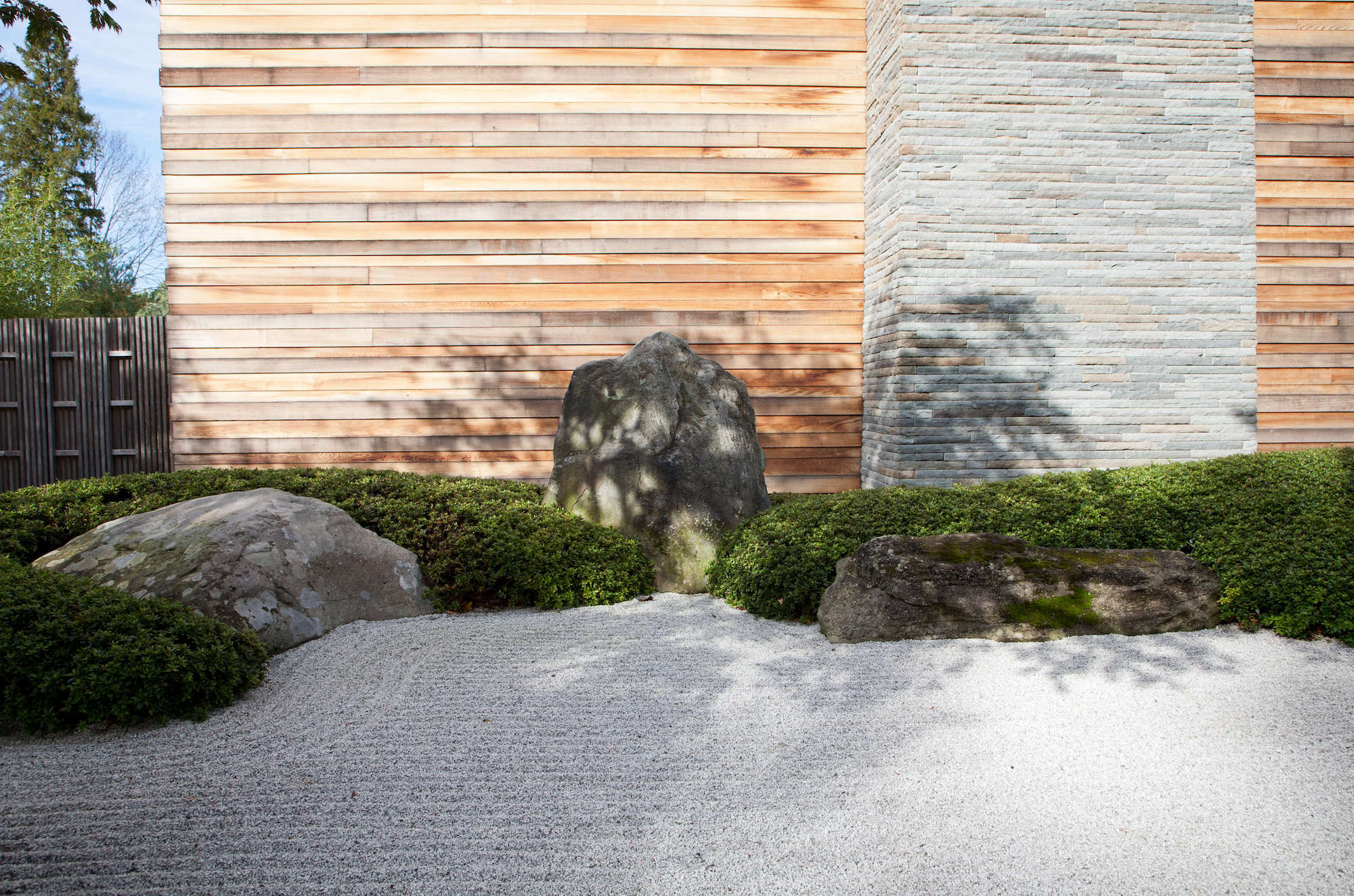When Peter Blum and his wife, Rita, had a modern house built in Irvington, New York, they hired a landscape architect to turn the existing grounds into an informal meadow landscape. But they saved one large patch of construction dirt for a different designer—Marc Peter Keane, a specialist in Japanese gardens.
“Peter and Rita are Swiss and they have very exacting eyes,” said Keane. “They like simple things, and they like Japan.” They wanted a Japanese-inspired garden in an empty space between their main house and a detached backyard office belonging to Peter, who owns Peter Blum Gallery in New York.
The garden was to serve two purposes—first, to transport people from the house to the studio, and second, to inspire contemplation—so Keane designed the garden in two parts. One section, the forest walk, is “a distillation of a forest path with a trail of irregular slabs and “is meant to be a bit difficult to walk on—to slow you down,” said Keane. The other side, the ocean garden, is meant for viewing at a distance: an ocean of white sand with carefully manicured islands and coastlines within.
Photography by and courtesy of Don Freeman.
 Above: From a stone terrace off the kitchen of the main residence, the forest walk leads to a detached studio behind the house. Keane used mondo grass liberally throughout the garden, in two varieties: standard mondo grass (as shown around the base of the Japanese maple at front), and a dwarf variety between the pathway stones.
Above: From a stone terrace off the kitchen of the main residence, the forest walk leads to a detached studio behind the house. Keane used mondo grass liberally throughout the garden, in two varieties: standard mondo grass (as shown around the base of the Japanese maple at front), and a dwarf variety between the pathway stones.
The tree at far left is a star magnolia. On the terrace is a stone lingam installed by the homeowner; it’s a common sculptural image in Hindu temples.
 Above: A Japanese snowbell tree (Styrax japonicus), surrounded by mondo grass, with clipped azaleas and a patch of enkianthus off to the left.
Above: A Japanese snowbell tree (Styrax japonicus), surrounded by mondo grass, with clipped azaleas and a patch of enkianthus off to the left.
For the forest walk, Keane took inspiration from a traditional Japanese tea garden. Walking through it “becomes a cleansing, purifying passage,” he said. “The very short distance between the house and the office begins to feel a little bit longer.”
 Above: Keane used bluestone from the Catskills for both the large, flat slabs that comprise the forest walk and the small boulders that border the ocean garden, below.
Above: Keane used bluestone from the Catskills for both the large, flat slabs that comprise the forest walk and the small boulders that border the ocean garden, below.
Bluestone sometimes splits in curves, notes Keane, and he selected two curved pieces for this garden: one shown here, with a “river” of mondo grass flowing beneath it, and another framing the water basin, shown below.
 Above: To provide nutrients for the lush plants of the forest walk, Keane had the existing construction dirt removed and replaced with topsoil.
Above: To provide nutrients for the lush plants of the forest walk, Keane had the existing construction dirt removed and replaced with topsoil.
Keane got his start in Japanese garden design when he moved to Japan in the 1980s with the intention of staying for one year. He lived there for 20 years, studying Japanese gardens and eventually designing for Japanese clients.
 Above: Keane used a different type of stone for one feature only—a flowing water basin at the center of the garden, “to mark it as a separate entity.” He had the Connecticut stone, a metamorphic rock called gneiss, carved into a basin.
Above: Keane used a different type of stone for one feature only—a flowing water basin at the center of the garden, “to mark it as a separate entity.” He had the Connecticut stone, a metamorphic rock called gneiss, carved into a basin.
Directly behind the basin is a compact Japanese maple tree, and behind the water source is a Japanese andromeda with an autumn fern in front. The pale green grass at far right is golden Japanese forest grass, Hakonechloa macra ‘Aureola.’
 Above: The exterior of the house is sided with clear (or knotless) cedar. The interior, notes Keane, is “extremely simple, with high ceilings.”
Above: The exterior of the house is sided with clear (or knotless) cedar. The interior, notes Keane, is “extremely simple, with high ceilings.”
 Above: The ocean, or sand, garden is not meant to be entered (except during maintenance). To that end, Keane had a thick slab of clear cedar embedded into the side wall of the studio, so the owners and guests can sit in contemplation.
Above: The ocean, or sand, garden is not meant to be entered (except during maintenance). To that end, Keane had a thick slab of clear cedar embedded into the side wall of the studio, so the owners and guests can sit in contemplation.
 Above: The boulders and small-leafed azaleas (Azalea macrantha) in the ocean garden symbolize islands and coastlines. Gardener Asher Browne, who trained in Japan, visits the garden about four times a year to prune the plants and thin the bamboo grove (visible behind the fence) once a year.
Above: The boulders and small-leafed azaleas (Azalea macrantha) in the ocean garden symbolize islands and coastlines. Gardener Asher Browne, who trained in Japan, visits the garden about four times a year to prune the plants and thin the bamboo grove (visible behind the fence) once a year.
 Above: The sand that comprises the ocean garden is finely crushed white granite.
Above: The sand that comprises the ocean garden is finely crushed white granite.
 Above: The primary concern in the ocean garden was not lack of nutrients, but adequate drainage. Keane had a system of perforated pipes installed in a trench below the sand. “There is quite a substructure to that garden so that it drains properly,” he said.
Above: The primary concern in the ocean garden was not lack of nutrients, but adequate drainage. Keane had a system of perforated pipes installed in a trench below the sand. “There is quite a substructure to that garden so that it drains properly,” he said.
 Above: Daily raking is required to keep a sand garden looking precise, said Keane, but if precision is not what you’re after, it can be raked every one to two weeks. In this garden, Asher Browne rakes the ocean garden as his last task when he visits.
Above: Daily raking is required to keep a sand garden looking precise, said Keane, but if precision is not what you’re after, it can be raked every one to two weeks. In this garden, Asher Browne rakes the ocean garden as his last task when he visits.
 Above: An island of mondo grass and small-leafed azalea surrounds a Japanese maple tree.
Above: An island of mondo grass and small-leafed azalea surrounds a Japanese maple tree.
 Above: Like the walkway stones in the forest garden, the boulders in the ocean garden are bluestone from the Catskill Mountains. “They are all from the same geology,” said Keane.
Above: Like the walkway stones in the forest garden, the boulders in the ocean garden are bluestone from the Catskill Mountains. “They are all from the same geology,” said Keane.
 Above: Keane had a bamboo grove planted beyond the garden; before, he says, “there was too much sky,” power lines included. “These sorts of gardens feel better if they’re somewhat enclosed, and you have a sense of intimacy.”
Above: Keane had a bamboo grove planted beyond the garden; before, he says, “there was too much sky,” power lines included. “These sorts of gardens feel better if they’re somewhat enclosed, and you have a sense of intimacy.”
A Japanese-inspired fence borders the garden on one side; solid cypress planks abut the bamboo grove, and a lattice pattern of vertical struts comprises the sides. It’s a nice effect, says Keane, “to layer the manmade fence against the natural bamboo grove.”
 Above: The rake for the ocean garden.
Above: The rake for the ocean garden.
See another of Keane’s gardens in Designer Visit: A Gray and Green Garden at Tiger Glen, and find more Japanese inspiration in: